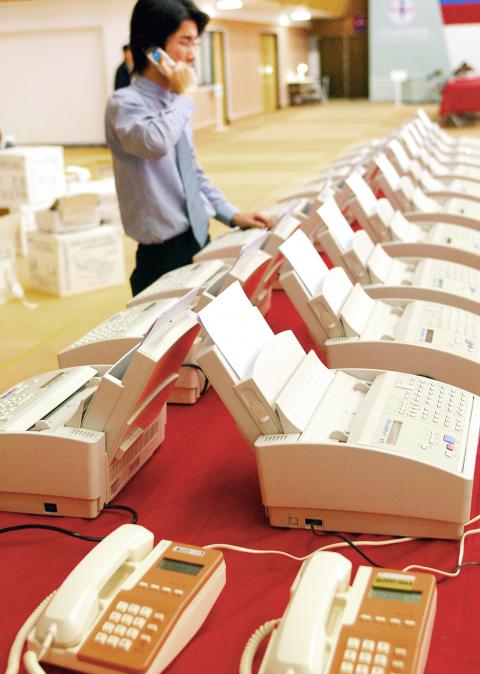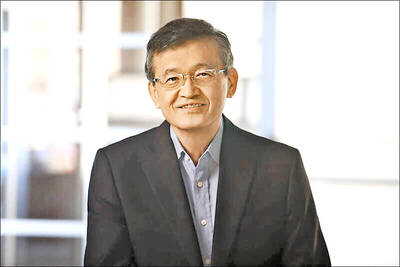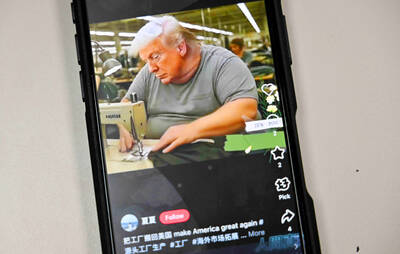It may have slipped from its golden age into its golden years, but two decades into the Internet era the fax machine is still, perhaps surprisingly, holding its place in many offices.
While it has been reduced to a small player in the rapidly growing world of digital communications, “millions of people still use fax machines daily worldwide and probably will continue to do so in the near future,” said Jonathan Coopersmith, an associate professor at Texas A&M University, who has written a book on the history of the once ubiquitous office machine.
Even more surprising, people and companies continue to buy new fax machines.

Photo: AFP
“Sales are dropping regularly due to e-mails, but the market is far from disappearing,” said Nicolas Cintre, deputy director in France for Japanese company Brother Industries Ltd, the market leader in fax machines.
About 20 million fax terminals were sold in 2005, manufacturers estimate, while sales today are on the order of several million.
“The market is holding up. Those who predicted the death of the fax 10 years ago were wrong,” Cintre said.
Part of the reason for the machine’s survival is an attachment among “older generations” who spent most of their careers using it, he said.
“Some habits are hard to break,” he said.
It is considered by some as a tool for older employees reluctant to learn new technologies, but the fact that it embraces handwriting — in particular signatures — has also helped the fax avoid obsolescence.
“Fax machines allow sending signed documents, which are considered as originals, which isn’t the case with e-mail,” said Jean Champagne, head of Sagemcom Canada, the unit of the communications equipment company that markets fax systems.
Coopersmith said that “in most countries, faxing is concentrated in certain areas such as banking, real estate, legal communications and medicine — where a written signature is necessary.”
Regulations might require faxing in some countries, he added.
Champagne also said that faxes offer advantages in terms of confidentiality and security, another reason why the machines remain popular in the legal and medical fields.
“It is nearly impossible to intercept fax transmissions. Documents cannot be manipulated,” he said.
The fax has aged better in some countries than others. In the US, fax machines have pretty much disappeared. Xerox Corp, which built the first machine for the general public, stopped selling basic models several years ago.
However, in Japan, where they have long been an essential feature of homes as well as offices, faxes are still in widespread use. They were even deployed by the authorities in 2011 to disseminate some information during the Fukushima Dai-ichi nuclear accident.
“Per capita, the greatest fax use still occurs in Japan, especially among older people who grew up writing by hand, not typing on a keypad,” Coopersmith said.
It is not just the elderly — many Japanese users of varying ages favor the fax for allowing them to send off handwritten notes.
“For many people and small businesses, faxing a written note or a form is easier than typing on a computer or smartphone,” Coopersmith added.
Nearly 1.2 million basic fax machines were sold in Japan last year, and sales are forecast to dip to 1.1 million this year, according to the association of telecommunications companies.
“The use of fax machines fell with the massive spread of computers and smartphones, but people over 60 who are not familiar with the new technologies prefer the fax,” said Miyuki Nakayama, spokesman for electronics manufacturer Sharp Corp.
Europe is somewhere in the middle, according to Cintre.
In France, about 40,000 basic fax machines were sold in 2013, according to market researcher GfK.
Though sales of simple fax machines are declining, that does not necessarily mean that faxes are disappearing. Instead, the fax is increasingly being wrapped into “multi-function” or “all-in-one” machines that are gaining popularity in the market. These offer consumers printing, scanning, photocopying and faxing functions.
This is the direction that Brother, Cannon Inc, Epson Corp and Hewlett-Packard Co have taken. Others are using software to mimic fax functions, essentially sending facsimiles as attachments to e-mails.
“This sector is booming,” said Champagne, who said the “faxware” sector is growing by nearly 20 percent per year.
So even if fax machines eventually disappear, the fax function will endure in other devices in homes and offices
“Faxing will decline as its older users die but it will not disappear,” Coopersmith said. “If nothing else, faxing serves as an inexpensive and backup emergency communications system.”

Intel Corp chief executive officer Lip-Bu Tan (陳立武) is expected to meet with Taiwanese suppliers next month in conjunction with the opening of the Computex Taipei trade show, supply chain sources said on Monday. The visit, the first for Tan to Taiwan since assuming his new post last month, would be aimed at enhancing Intel’s ties with suppliers in Taiwan as he attempts to help turn around the struggling US chipmaker, the sources said. Tan is to hold a banquet to celebrate Intel’s 40-year presence in Taiwan before Computex opens on May 20 and invite dozens of Taiwanese suppliers to exchange views

Application-specific integrated circuit designer Faraday Technology Corp (智原) yesterday said that although revenue this quarter would decline 30 percent from last quarter, it retained its full-year forecast of revenue growth of 100 percent. The company attributed the quarterly drop to a slowdown in customers’ production of chips using Faraday’s advanced packaging technology. The company is still confident about its revenue growth this year, given its strong “design-win” — or the projects it won to help customers design their chips, Faraday president Steve Wang (王國雍) told an online earnings conference. “The design-win this year is better than we expected. We believe we will win

Chizuko Kimura has become the first female sushi chef in the world to win a Michelin star, fulfilling a promise she made to her dying husband to continue his legacy. The 54-year-old Japanese chef regained the Michelin star her late husband, Shunei Kimura, won three years ago for their Sushi Shunei restaurant in Paris. For Shunei Kimura, the star was a dream come true. However, the joy was short-lived. He died from cancer just three months later in June 2022. He was 65. The following year, the restaurant in the heart of Montmartre lost its star rating. Chizuko Kimura insisted that the new star is still down

While China’s leaders use their economic and political might to fight US President Donald Trump’s trade war “to the end,” its army of social media soldiers are embarking on a more humorous campaign online. Trump’s tariff blitz has seen Washington and Beijing impose eye-watering duties on imports from the other, fanning a standoff between the economic superpowers that has sparked global recession fears and sent markets into a tailspin. Trump says his policy is a response to years of being “ripped off” by other countries and aims to bring manufacturing to the US, forcing companies to employ US workers. However, China’s online warriors